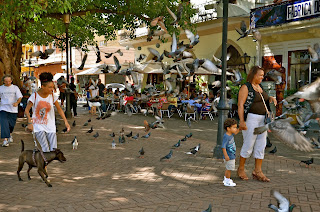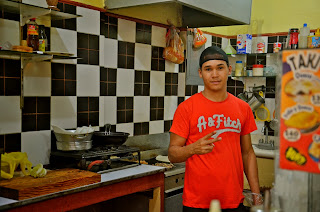
Santo Domingo, known officially as Santo Domingo de Guzmán, is the capital and largest city in the Dominican Republic. It is a large city with a population of over 3 million. We stayed in the Colonial Zone, a city within a city, much like the French Quarter in New Orleans.
Although Santo Domingo has a high crime rate, the Colonial Zone is well patrolled with police and tourists come and go throughout the day and night. Our hotel, Hotel Atarazana, was located near the river in the Colonial Zone and was close to all the sights of the historical city zone.
While we followed general travelers' safety advice (no flashy jewelry, money belt around LA's waist, camera hidden out of sight), at no time did we feel unsafe. We walked everywhere we went.
Once we arrived at our hotel, we were eager to explore the city. Our first order of business was to find a lunch spot where the locals eat. Niurka from the hotel recommended a small diner, El Taquito, right around the corner from the hotel. After walking down the street, we turned the corner, and we had to walk around some construction. I mean MAJOR construction. The entire street had been dug up! We managed to walk down the sidewalk, jump a few deep pits, balance on a few boards... and arrived at the diner. Welcome to Santo Domingo!
El Taquito did not disappoint. The Dominican cuisine was very similar to Mexico's food. We had quesadillas with salsa and LA enjoyed Presidente beer, which was served very cold.
 |
After lunch, we headed to the main hub of activity of the Colonial Zone. The Parque Colon is a gathering place for locals and tourists alike.

We walked around the park, then settled in at a sidewalk cafe for people watching.
Sights from the Parque Colon:
 |
| Local Dominican Artist Sketching as Friends Look On |
 |
| People-Watching from Sidewalk Cafes |
 |
| These Guys Take their Domino Games Seriously! |
 |
| Young Boy Feeding Pigeons under the Watchful Eye of his Parents |
 |
| A Vendor Hawking Mamajuana |
Vendors hawk all kinds of things... including mamajuana. What's Mamajuana? It's not what it sounds like... It's a drink that is concocted by allowing rum, red wine, and honey to soak in a bottle with tree bark and herbs. Besides being rumored to be an aphrodisiac, Mamajuana is also consumed for its medicinal value as a flu remedy, a digestion and circulation aid, a blood cleanser, and kidney and liver tonic.

Vendor cart filled with candy and toys to entice children.
There is a closed off pedestrian street filled with shops of all kinds. Vendors set up shop on the sidewalk to display their wares.
Local art display. Not our taste. At. All. Who buys this stuff?? Click on the photo to get an up close view of the "art".



Shop girl waiting for customers.
There were some, ah, "interesting" clothing shops. Santo Domingo is home to many, many "ladies of the evening". I guess the Colonial Zone is the place to go when planning one's trolling wardrobe.
Back to the tour... We loved the beautiful Spanish architecture. It was like stepping back in time to walk the streets that were once walked by Christopher Columbus.

The neighborhoods of the Colonial Zone were quaint and colorful.

Horse drawn carriage tours were a slow relaxing ride around the Colonial Zone.

The carriages were very colorful. We heard that the guides gave a great tour and talked about the history of the Colonial Zone... but it was in Spanish!
There were some lovely balconies overlooking the streets. The bars covering the windows were very ornamental, making it easy to forget that these are actually security measures.

Apartments are located above the local shops all around the Colonial Zone.

Pretty window boxes with bougainvillea adorn a staircase to an upstairs apartment.
There were some interesting gates around the city. This gate leads to a courtyard outside a famous cathedral.

This gate guards the entrance to the cathedral.
 |
| LA strolls past a gated entrance to a Dominican home. |

Cobblestone streets and old lantern light fixtures add to the charm of the city.

Where do the local Dominicans live? Here is a local neighborhood just outside the Colonial Zone. Everyone visits in the streets, especially in late afternoon after siesta time is over.

Young boys play games in the street.
Santo Domingo has the distinction of being the first city in the "New World". They are a city of "firsts". They hold claim to the first cathedral, monastery, university, customs house and hospital in the "New World". . There are over three hundred pieces of history including the monuments, homes, streets and churches in the Colonial Zone.
 This is a famous statue in the Parque Colon. It is Christopher Columbus/ Cristobal Colon for whom the park is named. This bronze statue dates back from 1897 and is the work of French sculptor Gilbert. It shows a native Taino woman known as Anacaona reaching to Columbus standing atop the pillar in his arrogant glory. The statue is located directly in front of the Catedral Santa Maria (the oldest cathedral in all Las Americas).
This is a famous statue in the Parque Colon. It is Christopher Columbus/ Cristobal Colon for whom the park is named. This bronze statue dates back from 1897 and is the work of French sculptor Gilbert. It shows a native Taino woman known as Anacaona reaching to Columbus standing atop the pillar in his arrogant glory. The statue is located directly in front of the Catedral Santa Maria (the oldest cathedral in all Las Americas).Many of Santo Domingo's most notable landmarks are located within the Zona Colonial district of the city, a UNESCO World Heritage Site since 1990. The Colonial Zone, bordered by the Río Ozama river and the Caribbean Sea, has an impressive collection of 16th century buildings, including palatial houses and majestic churches that reflect the Spanish architectural style of the late medieval period dating back to the time of Christopher Columbus' arrival in 1492.
Palacio Virreinal Alcázar de Colón/ Columbus Palace is a 22 room stone home built by Columbus's son Don Diego Colón (Colon is the Spanish word for Columbus) and his wife Maria de Toledo in the early 1500s. Not one single nail was used in its' construction. They resided in this 50 room Viceregal palace during Diegos' term as viceroy until 1523 when he was recalled to Spain. The building was abandoned in 1770 and turned into a garbage dump. Cave-ins in 1809 and 1835 left the building in ruins. It was restored by highly skilled stone cutters and opened to the public on Columbus Day 1957. This photo was taken of Columbus Palace from the roof terrace of our hotel.
We walked around the outside of the palace grounds and the wall around the perimeter of the palace.

This old stone arch was covered in graffiti.
Cathedral de Santa Maria/ The Cathedral of Santa Maria - Cathedral of Santo Domingo is the crown jewel of landmarks in Santo Domingo. It is the first church/cathedral in the Americas.
 Originally when this church was built in 1514 it was a hut made of royal palms. It now takes up an entire block.
Originally when this church was built in 1514 it was a hut made of royal palms. It now takes up an entire block. The church was worked on and designed by so many different people which resulted in many architectural styles. There are Roman style arches and Gothic style vaults with some Baroque ornaments thrown in.

It is built with the coralline blocks and has been able to withstand the ravages of time. It is a majestic sight to behold.

The arched Gothic-style windows on the second floor where the Royal Court was held gave a perfect view of a sun dial so they always knew what time it was. (The sun dial is located on the right of the photo.) This sun dial is not just any sun dial. It was erected during the reign of Carlos III in 1753 and is one of the oldest sun dials in all the Americas.

These days, the stone courtyard overlooking the river attracts tourists and street vendors. I am buying bottled water for 20 pesos from this vendor...
...but everyone else is heading over to the ice cream vendor who is located behind me in this photo. Did I want some ice cream? You bet I did! But I had been warned not to buy it from street vendors. You don't know how many times it has melted and re-frozen... which can cause la tourista... traveler's diarrhea! Yuk!

Museo de las Casas Reales/ Museum of the Royal Houses has artifacts and other historical exhibits from Santo Domingo during the island's Hispanic period 1492 to 1821. The most important attraction is the building itself, the first courthouse that controlled the New World.

Palace of Borgellá is a beautiful 2 story building noted for its large colonial style arches and old Caribbean flair.
 |
This building with its affluent style, built at the beginning of the 16th century by Haitian G.M. Borgellá, now houses a museum.
The Palacio Consistoral is distinguished by its' clock tower. This building was constructed in the early 1500's and was the original location of the old town hall. This historical building now is mainly used for cultural events and art exhibits.
Fuerte de la Carena is a small bunker located to the north of Fuerte de Angulo dating back to 1543. This is part of the fort where boats were brought for repair. It was rebuilt on its original foundation in 1991. In the background you can see Malecon Boulevard, which runs along the river.
Bateria del Almirante/ Battery of the Admiral was built as a double-sided wall where one could walk the perimeter of the Atarazanas and Alcazar de Colon next to the river. In the 1500's, the river was very close to the walls. There was always activity and ships coming and going and this was the perfect vantage point to view all.

The Fortress of Santo Domingo is also known as Fortaleza Ozama. (Ozama is the Taino word for navigable waters or wetlands). The fort is considered to be one of the oldest of its kind on the entire American continent. Built between 1502 and 1508 using the labor of African and Taino slaves, the fort extends from the eastern to the western bank of the Ozama River/Rio Ozama. The Governor Frey Nicolas de Ovando, founder of the city of Santo Domingo, chose this spot for his military installation.
We enjoyed our trip to Santo Domingo, a city of culture, charm, and history.



















No comments:
Post a Comment